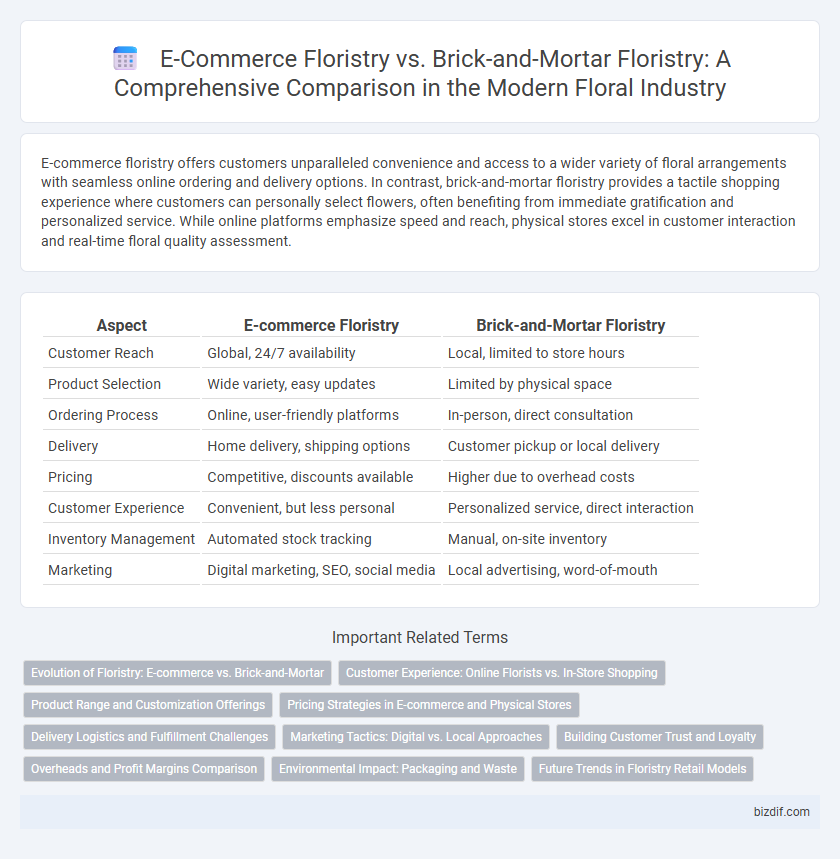E-commerce floristry offers customers unparalleled convenience and access to a wider variety of floral arrangements with seamless online ordering and delivery options. In contrast, brick-and-mortar floristry provides a tactile shopping experience where customers can personally select flowers, often benefiting from immediate gratification and personalized service. While online platforms emphasize speed and reach, physical stores excel in customer interaction and real-time floral quality assessment.
Table of Comparison
| Aspect | E-commerce Floristry | Brick-and-Mortar Floristry |
|---|---|---|
| Customer Reach | Global, 24/7 availability | Local, limited to store hours |
| Product Selection | Wide variety, easy updates | Limited by physical space |
| Ordering Process | Online, user-friendly platforms | In-person, direct consultation |
| Delivery | Home delivery, shipping options | Customer pickup or local delivery |
| Pricing | Competitive, discounts available | Higher due to overhead costs |
| Customer Experience | Convenient, but less personal | Personalized service, direct interaction |
| Inventory Management | Automated stock tracking | Manual, on-site inventory |
| Marketing | Digital marketing, SEO, social media | Local advertising, word-of-mouth |
Evolution of Floristry: E-commerce vs. Brick-and-Mortar
E-commerce floristry has revolutionized the flower industry by offering expansive product selections, personalized arrangements, and convenient delivery options through digital platforms, significantly increasing consumer reach beyond local markets. Brick-and-mortar floristry continues to thrive by providing tactile customer experiences, immediate product availability, and face-to-face consultations that foster emotional connections and trust. The evolution of floristry reflects a hybrid model where online accessibility and physical presence complement each other, driving innovation in floral design, ordering systems, and customer engagement strategies.
Customer Experience: Online Florists vs. In-Store Shopping
E-commerce floristry offers customers convenience, extensive flower variety, and personalized online ordering with delivery options, enhancing accessibility and saving time. Brick-and-mortar florists provide tactile experiences, immediate product inspection, and face-to-face interactions that build trust and allow for real-time customization. Both platforms prioritize customer satisfaction but differ in engagement style, with online florists leveraging technology and data-driven recommendations while physical stores emphasize sensory connection and personal rapport.
Product Range and Customization Offerings
E-commerce floristry offers an extensive product range with access to diverse global flower varieties and customizable bouquet options tailored through user-friendly online tools. Brick-and-mortar florists provide personalized, hands-on customization experiences with immediate product availability, allowing for last-minute changes and physical inspection of floral arrangements. Both models emphasize unique customization, but e-commerce excels in variety and convenience, while brick-and-mortar prioritizes tactile engagement and local sourcing.
Pricing Strategies in E-commerce and Physical Stores
E-commerce floristry often adopts dynamic pricing strategies leveraging real-time data analytics, allowing for personalized discounts, flash sales, and competitive pricing based on demand fluctuations and customer behavior. Brick-and-mortar florists typically use fixed pricing with periodic promotions tied to seasonal events, focusing on in-store experience and perceived value to justify higher price points. Digital platforms benefit from reduced overhead costs, enabling more flexible pricing, whereas physical stores rely on direct customer interactions to enhance value perception despite higher operational expenses.
Delivery Logistics and Fulfillment Challenges
E-commerce floristry relies heavily on advanced delivery logistics, including temperature-controlled packaging and real-time tracking, to ensure the freshness and timely arrival of flowers. Brick-and-mortar florists manage fulfillment through local, immediate customer interactions, which reduces the risk of damage but limits geographic reach. Challenges for e-commerce include handling perishable inventory at scale and addressing last-mile delivery complexities, while physical stores face constraints in inventory variety and higher overhead costs.
Marketing Tactics: Digital vs. Local Approaches
E-commerce floristry leverages digital marketing tactics such as search engine optimization (SEO), social media advertising, and targeted email campaigns to reach a broad online audience efficiently. Brick-and-mortar florists focus on local marketing strategies including in-store promotions, community partnerships, and localized advertising to build strong neighborhood customer relationships. Both approaches aim to maximize visibility and sales but differ fundamentally in audience targeting and engagement methods.
Building Customer Trust and Loyalty
E-commerce floristry leverages customer reviews, detailed product images, and seamless online support to build trust quickly, enhancing customer loyalty through personalized recommendations and subscription services. Brick-and-mortar florists foster trust by offering direct, sensory experiences with fresh flowers and face-to-face interactions, cultivating long-term loyalty through personalized service and local community engagement. Combining transparent quality assurance, reliable delivery systems, and consistent customer engagement strategies strengthens trust and drives repeat business across both sales channels.
Overheads and Profit Margins Comparison
E-commerce floristry typically benefits from lower overhead costs by eliminating the need for physical retail space and reducing expenses related to in-store staff and utilities, leading to higher profit margins. Brick-and-mortar florists incur significant fixed costs such as rent, utilities, and in-person staffing, which can compress profit margins despite potentially higher per-sale prices. The digital platform's scalability allows online florists to optimize inventory management and reduce waste, further enhancing profitability compared to traditional floral shops.
Environmental Impact: Packaging and Waste
E-commerce floristry generates higher volumes of packaging waste due to the need for protective materials and shipping boxes, increasing its carbon footprint compared to brick-and-mortar florists. Brick-and-mortar floristry benefits from reduced packaging by allowing customers to select and transport flowers themselves, minimizing disposable materials. Sustainable packaging innovations and efficient logistics are crucial for e-commerce florists aiming to reduce environmental impact.
Future Trends in Floristry Retail Models
E-commerce floristry is rapidly evolving with the integration of AI-driven personalization and augmented reality for virtual bouquet customization, appealing to tech-savvy consumers seeking convenience and unique experiences. Brick-and-mortar floristry is adapting by offering immersive in-store experiences and same-day delivery services to maintain local customer loyalty. The future of floristry retail models lies in a hybrid approach that combines digital innovation with tactile, sensory engagement to meet diverse customer preferences.
E-commerce floristry vs Brick-and-mortar floristry Infographic

 bizdif.com
bizdif.com